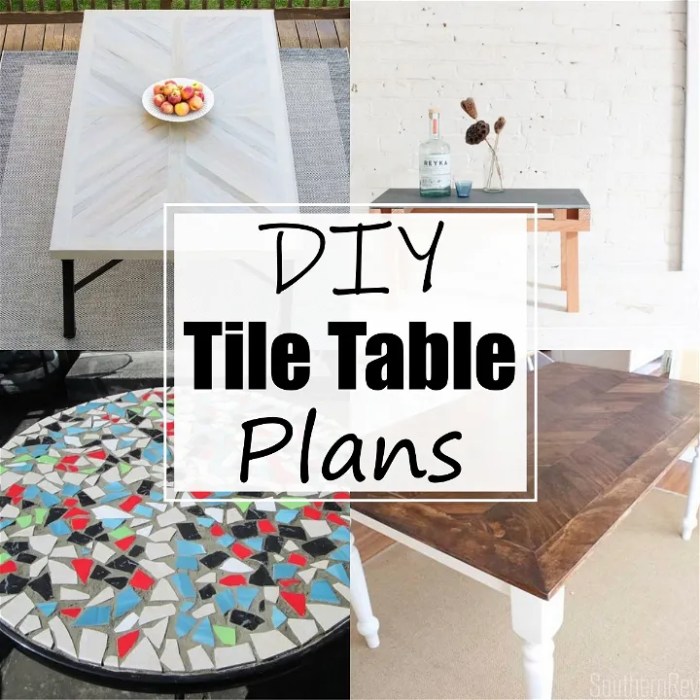DIY tile tables offer a fantastic opportunity to personalize your home decor with a touch of creativity and style. Whether you’re a seasoned DIY enthusiast or a beginner looking for a rewarding project, building a tile table is a fun and fulfilling endeavor. From choosing the perfect tiles to crafting a sturdy base, the process allows you to express your individual taste and create a piece that reflects your unique personality.
The beauty of DIY tile tables lies in their versatility. You can create a table that seamlessly complements any room style, from modern and minimalist to rustic and farmhouse. The possibilities are endless, with a wide array of tile patterns, colors, and textures available to bring your vision to life.
Building the Table Base: Diy Tile Table

The table base is the foundation of your tile table, providing stability and support for the tabletop. It’s crucial to choose a construction method that suits your desired style and ensures the base can handle the weight of the tiles.
Table Base Construction Methods, Diy tile table
There are several methods to build a table base, each with its advantages and disadvantages.
- Simple Legs: This is the most straightforward approach, using four legs attached to the tabletop. It’s easy to build and offers a clean, minimalist aesthetic. However, it may not be as sturdy as other options.
- X-Frame Base: This design uses two diagonal supports that intersect in the middle, creating an “X” shape. It’s more stable than simple legs and adds visual interest. It’s suitable for smaller tables, but may not be ideal for heavier tabletops.
- Box Frame Base: This method uses a box-shaped frame constructed from wood or metal. It provides exceptional stability and can support heavier tabletops. It’s also versatile and allows for various design variations.
- Pedestal Base: This option features a single central support, usually made of wood or metal. It’s a good choice for larger tables, as it creates a sense of openness and minimizes visual clutter. However, it requires careful planning and execution to ensure stability.
Materials for Table Base Construction
The choice of material depends on your design preferences, budget, and desired durability.
- Wood: A classic and versatile material, wood offers warmth and natural beauty. It’s relatively easy to work with and can be stained or painted to match your desired style. Common choices include pine, oak, maple, and walnut. Consider using hardwoods for increased strength and durability.
- Metal: Metal offers excellent strength and durability, making it ideal for heavier tabletops or outdoor use. Steel, aluminum, and iron are popular choices. Metal can be welded, bolted, or screwed together, providing flexibility in design and construction.
- Other Materials: For unique designs, you can explore other materials like concrete, acrylic, or even repurposed items. Concrete offers a modern and industrial aesthetic, while acrylic provides a sleek and transparent look. Repurposed materials can add character and sustainability to your table base.
Step-by-Step Guide for Building a Sturdy Table Base
This guide focuses on building a simple table base using wood, but the principles can be adapted to other materials and designs.
- Gather Materials:
- Wood for the legs (4 pieces)
- Wood for the tabletop support (optional)
- Wood screws or bolts
- Wood glue
- Sandpaper
- Paint or stain (optional)
- Cut the Wood: Measure and cut the wood for the legs to your desired length. If using a tabletop support, cut the pieces to the appropriate size. Ensure the cuts are accurate and square.
- Assemble the Legs: If using a tabletop support, attach the legs to the support using wood screws or bolts. Otherwise, attach the legs directly to the tabletop. Make sure the legs are securely fastened and aligned.
- Sand and Finish: Sand the entire table base to smooth out any rough edges or imperfections. Apply paint or stain if desired. Allow the finish to dry completely before using the table.
Creating a DIY tile table is a journey of discovery, allowing you to explore your artistic side while crafting a functional and beautiful piece for your home. With careful planning, attention to detail, and a touch of creativity, you can transform a simple table into a stunning centerpiece that will be admired for years to come. So, gather your tools, choose your favorite tiles, and embark on this rewarding DIY adventure!
A DIY tile table can be a stylish and durable addition to your home. If you have a furry friend, you might also want to consider building a DIY puppy ramp to help them get up on the couch or bed. You can find a great tutorial for a DIY puppy ramp on this website , which includes detailed instructions and helpful tips.
Once you’ve built a ramp for your pup, you can move on to creating that beautiful tile table you’ve been dreaming of!
